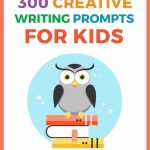Unlock The Imagination: Enroll Your Child In Our Engaging Creative Writing Elementary School Program Today!
Creative Writing in Elementary School: Nurturing Young Minds Through Words
Introduction: Unleashing the Power of Words
Dear Readers,
2 Picture Gallery: Unlock The Imagination: Enroll Your Child In Our Engaging Creative Writing Elementary School Program Today!


Welcome to our article on creative writing in elementary school, where we explore the wonderful world of words and their impact on young minds. In today’s fast-paced digital era, it’s becoming increasingly important to develop strong writing skills from an early age. Creative writing not only allows children to express themselves but also fosters critical thinking, communication, and empathy. In this article, we will delve into the various aspects of creative writing in elementary school, its benefits, and how it can shape the future of our children.
What is Creative Writing Elementary School?

Image Source: waterford.org
🖊️ Creative writing in elementary school refers to the process of encouraging students to use their imagination and express their thoughts, ideas, and emotions through writing. It goes beyond the traditional forms of writing and prompts children to explore their creativity by crafting stories, poems, plays, and more. Through creative writing, students develop essential skills such as vocabulary expansion, grammar, sentence structure, and storytelling techniques.
Who Can Benefit from Creative Writing?
📚 Creative writing is beneficial for all elementary school students, regardless of their academic abilities or interests. It offers a platform for self-expression and allows students to discover their unique voice. Whether a child dreams of becoming a writer or not, creative writing nurtures essential skills that are transferable to various fields such as communication, problem-solving, and critical thinking.
When and Where to Introduce Creative Writing?
🏫 Creative writing can be introduced as early as kindergarten and continued throughout elementary school. It can be incorporated into language arts classes, English lessons, or even as standalone workshops or extracurricular activities. The flexibility of creative writing allows it to be integrated into different subjects, making it accessible to all students across various settings.
Why Creative Writing is Essential in Elementary School?

Image Source: shortpixel.ai
💡 Creative writing plays a crucial role in elementary school education for several reasons. Firstly, it encourages self-expression and helps children develop their unique voice. It fosters imagination and creativity, allowing students to think outside the box and explore different perspectives. Additionally, creative writing enhances language skills, including grammar, vocabulary, and sentence structure. It also provides an avenue for emotional and social development by promoting empathy and understanding.
How to Foster Creative Writing Skills?
✍️ To foster creative writing skills in elementary school, educators can use various strategies. Firstly, they can provide engaging writing prompts or story starters to inspire students’ imagination. Encouraging free writing and journaling allows children to write without constraints. Additionally, incorporating peer feedback and group discussions can enhance collaboration and critical thinking. Creating a supportive and inclusive environment where students feel safe to express themselves is crucial for nurturing their creative writing abilities.
Advantages and Disadvantages of Creative Writing in Elementary School
Advantages: Unlocking Potential Through Words
1. 🌟 Enhanced Communication Skills: Creative writing helps students develop effective communication skills, both written and verbal. It enables them to express their thoughts and ideas clearly and persuasively.
2. 🌟 Critical Thinking and Problem Solving: Through creative writing, students learn to analyze information, think critically, and solve problems. They develop the ability to approach challenges from multiple perspectives and find innovative solutions.
3. 🌟 Empathy and Emotional Intelligence: Creative writing allows students to explore emotions and empathize with characters and situations. It helps them understand different perspectives and develop emotional intelligence.
4. 🌟 Boosts Confidence: By honing their writing skills and sharing their work, students gain confidence in their abilities. Creative writing provides a platform for self-expression and recognition, fostering a sense of achievement.
5. 🌟 Life-long Skill: The skills developed through creative writing are invaluable and can be applied in various aspects of life, including education, career, and personal growth.
Disadvantages: Challenges to Overcome
1. ⏳ Time Constraints: Incorporating creative writing into the curriculum requires time and planning, which can be challenging for teachers with limited resources.
2. 💻 Digital Distractions: With the rise of technology, students may be more inclined towards digital media, making it crucial to strike a balance between online and offline writing experiences.
3. 📏 Assessing Creativity: Evaluating creative writing can be subjective, as creativity cannot be quantified. Teachers need to develop fair and inclusive assessment methods that encourage students’ unique expression.
4. 👥 Varied Skill Levels: In a diverse classroom setting, students may have different writing abilities and experiences. Teachers need to provide support and differentiation to ensure all students can actively participate and improve.
5. 🖊️ Writer’s Block: Creative writing involves taking risks and exploring new ideas, which can lead to writer’s block. Teachers should provide guidance and strategies to help students overcome this hurdle and rediscover their inspiration.
Frequently Asked Questions (FAQs)
1. Is creative writing only for students with a natural talent for writing?
No, creative writing is for all students, regardless of their writing abilities. It focuses on nurturing creativity and self-expression, allowing every child to explore their unique voice.
2. How can creative writing benefit students in other subjects?
Creative writing enhances critical thinking, problem-solving, and communication skills, which are applicable to various subjects. It encourages students to think creatively and express their understanding in innovative ways.
3. Can creative writing help shy or introverted students?
Absolutely! Creative writing provides a safe and inclusive space for shy or introverted students to express themselves without feeling judged. It boosts their confidence and promotes personal growth.
4. What if a student doesn’t enjoy creative writing?
While not every student may have an immediate passion for creative writing, it still offers valuable skills that can benefit them in the long run. Teachers can use different approaches to engage reluctant writers and help them discover the joy of creative expression.
5. How can parents support creative writing at home?
Parents can encourage creative writing at home by providing a quiet space for writing, reading and discussing stories together, and celebrating their child’s writing achievements. They can also explore writing prompts or activities that inspire their child’s imagination.
Conclusion: Inspiring the Writers of Tomorrow
In conclusion, creative writing in elementary school holds immense value in shaping young minds and preparing them for the future. By nurturing creativity, critical thinking, and empathy, it equips students with essential skills that extend far beyond the boundaries of writing. Let us embrace the power of words and encourage our children to explore their imagination, express their thoughts, and tell their stories. Together, we can inspire the writers of tomorrow.
Final Remarks: Unlocking the Potential Within
Dear Readers,
As we conclude this article, let us remember that creative writing in elementary school is not just about teaching grammar or vocabulary; it is about unlocking the potential within each child. By embracing creativity, we empower our children to become confident communicators, critical thinkers, and compassionate individuals. Let us continue to support and foster creative writing in our schools and communities, ensuring that every child’s voice is heard and celebrated.
This post topic: Creative Writing


